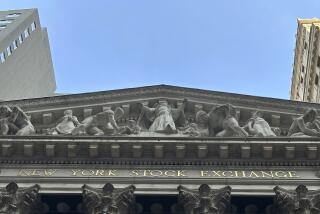What’s at Fault, the Business or the Piece of Paper?
“Everyone is a complete disappointment.”
-- New York beat poet John Giorno, 1977
*
Note to the Nasdaq Stock Market’s public relations advisors: Hunting for a new slogan--something a little more honest, if not exactly upbeat? The aforementioned line might resonate with many suffering investors this year.
Come to think of it, the New York Stock Exchange might get some mileage out of native son John Giorno’s famous utterance as well. Let’s sort through the pile-up of premier franchises that have deeply disappointed their share owners this year: AT&T;, Eastman Kodak, Gillette, Home Depot, Procter & Gamble and Xerox, to name a few.
By Wednesday, the last of the seemingly invincible technology sectors--the fiber-optics companies whose equipment makes Internet data (useless and otherwise) move at light speed--were in rapid retreat after Nortel Networks fell short of Wall Street’s lofty sales expectations.
Despite another end-of-week rebound, the Nasdaq composite index ended down 5.9% for the five days, the seventh loss in eight weeks.
The plunge in many start-up Internet-related stocks earlier this year cost a lot of investors plenty, but that was only a surprise to people whose idea of ancient history on Wall Street is 1998.
By contrast, the last two months have seen a wicked destruction of stock value at companies--tech and non-tech--whose names have been synonymous with global business success for the last decade, if not the last several decades.
But is that stock destruction truly an accurate reflection of the problems these companies face?
*
Someone once advised that investors, at times, must be able to separate a business from the piece of paper (i.e., the stock) that represents it. That is important because, although a business may not change much from day to day, the price of its stock can and will change dramatically--perhaps never more dramatically than what we’ve seen this year.
A closer look suggests that the “fall” of so many great franchises this year, at least as heralded by the action in their stocks, is really two separate stories.
One is a fundamental story of business strategies that have failed, or are viewed as in serious danger of failing. Shares of copier giant Xerox have gone from $60 to $8 in a year because the company terribly misjudged its marketplace and its ability to deliver the copiers and printers that potential customers wanted.
The law of the jungle prevailed here. “Xerox was slow to react to the technological changes taking place,” said Ned Riley, investment strategist at State Street Global Advisors in Boston. “Competitors then leaped to the forefront.”
In cases such as Xerox’s, there is no question that the source of the disappointment reflected in the stocks is the companies themselves.
But with many other formerly highflying growth stocks whose prices have crashed this year--including many tech companies--the stories of the underlying businesses still are success stories, by any fair measure.
What has changed is simply investors’ willingness to pay extraordinarily high share prices for a piece of that success. The disappointing performance of these stocks, then, isn’t management’s fault. The disappointment is the market’s own making in having valued these issues at levels that left no room for even a small corporate or economic misstep.
As Riley put it, “The [growth] hurdles that were established by the market were far out of reach of these companies.” Now, investors are taking a more rational view of what is possible in terms of earnings growth, not just in 2000 and 2001, but beyond.
The market has been through this before. A well-documented episode was in the early 1970s, when the so-called Nifty Fifty growth stocks of that era ran up to wild valuations--only to plummet in 1973-74, as the economy crashed and trust in effortless corporate profit growth evaporated.
What is startling is to view the peak growth stock price-to-earnings multiples of 1972 with the lofty levels (still) afforded to many of today’s growth stocks.
Today’s growth-company crop is far more promising, the firms’ fans say. It had better be.
*
Tom Petruno can be reached at [email protected]. For recent columns on the Web, go to http://vinapk.com/petruno.
(BEGIN TEXT OF INFOBOX / INFOGRAPHIC)
What Price for Growth?
Many Wall Street pros have compared investors’ appetite for technology stocks this year with the demand for select consumer growth stocks in the early 1970s. But even at the height of the 1972 “Nifty Fifty” stock era, stock price-to-earnings ratios didn’t come close to P/Es on many tech issues today. A sampling from both eras:
More to Read
Inside the business of entertainment
The Wide Shot brings you news, analysis and insights on everything from streaming wars to production — and what it all means for the future.
You may occasionally receive promotional content from the Los Angeles Times.










